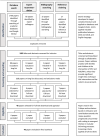A critical interpretive synthesis of the intersection of domestic violence with parental issues of mental health and substance misuse
- PMID: 32202363
- PMCID: PMC7497205
- DOI: 10.1111/hsc.12978
A critical interpretive synthesis of the intersection of domestic violence with parental issues of mental health and substance misuse
Abstract
A critical interpretive synthesis (CIS) methodology was used with the aim of informing practice with children and families when domestic and family violence (DFV) and parental issues relating to alcohol and other drugs (AOD) and mental health (MH) are also present. A CIS is grounded in the literature, but includes questioning of the literature in order to problematise gaps, contradictions and constructions of issues. A review of the literature from 2010 to 2018 was conducted with the structured search strategy identifying 40 relevant research articles. Synthesis and critique of these articles revealed three mutually informative themes through which to understand the literature and how it can inform practice. They were as follows: differences in theoretical approaches and client focus; complexity of system's collaboration; and practices converging on mothers. Taken together, these themes facilitated the development of the synthesising construct: strengthening intersection between DFV, AOD and MH sectors. Attention to practice at multiple levels that responds to the dynamics of gender and the differing impacts of violence was often lacking, particularly in the context of heightened child protection concerns where collaboration between sectors is needed. Both promising and problematic practices relating to gender dynamics and accountability converged on mothers. While there were exceptions, generally, there was an absence of engagement with, and recognition of, the impacts of fathers' patterns of using violence and control on adult and child survivors. Promising practice related to the strengthening of the mother-child relationship and attention to MH and its intersection with domestic violence. Strengthening the intersections between DFV, AOD and MH practices with attention to keeping the perpetrator of violence in view is critical to overcoming the poor practice that can occur when sectors are siloed from each other.
Keywords: child protection; children and families; critical interpretive synthesis; domestic and family violence; mental health; social work practice; substance misuse.
© 2020 The Authors. Health and Social Care in the Community published by John Wiley & Sons Ltd.
Figures
Similar articles
-
Review of Studies Regarding Assessment of Families Where Children Are at Risk of Harm Due to Parental Substance Misuse.Int J Environ Res Public Health. 2025 Apr 14;22(4):612. doi: 10.3390/ijerph22040612. Int J Environ Res Public Health. 2025. PMID: 40283836 Free PMC article. Review.
-
Parental domestic violence and abuse, mental ill-health, and substance misuse and the impact on child mental health: a secondary data analysis using the UK Millennium Cohort Study.BMC Public Health. 2024 Aug 26;24(1):2310. doi: 10.1186/s12889-024-19694-1. BMC Public Health. 2024. PMID: 39187800 Free PMC article.
-
Maternal mental health, substance use, and domestic violence in the year after delivery and subsequent behavior problems in children at age 3 years.Arch Gen Psychiatry. 2006 May;63(5):551-60. doi: 10.1001/archpsyc.63.5.551. Arch Gen Psychiatry. 2006. PMID: 16651512
-
"They had clothes on their back and they had food in their stomach, but they didn't have me": The contribution of parental mental health problems, substance use, and domestic violence and abuse on young people and parents.Child Abuse Negl. 2024 Mar;149:106609. doi: 10.1016/j.chiabu.2023.106609. Epub 2024 Jan 4. Child Abuse Negl. 2024. PMID: 38181566
-
Family focused interventions that address parental domestic violence and abuse, mental ill-health, and substance misuse in combination: A systematic review.PLoS One. 2022 Jul 29;17(7):e0270894. doi: 10.1371/journal.pone.0270894. eCollection 2022. PLoS One. 2022. PMID: 35905105 Free PMC article.
Cited by
-
OveRcoming Adverse ChiLdhood Experiences (ORACLE): A Mixed Methods Intervention Co-design Study to Improve Outcomes for Children and Young People Experiencing or at Risk of Adversity.J Prev (2022). 2025 Aug 11. doi: 10.1007/s10935-025-00866-7. Online ahead of print. J Prev (2022). 2025. PMID: 40788588
-
Gender, Addiction, and Removal of Children Into Care.Front Psychiatry. 2022 Jun 2;13:887660. doi: 10.3389/fpsyt.2022.887660. eCollection 2022. Front Psychiatry. 2022. PMID: 35722570 Free PMC article.
-
Harms to children from men's heavy drinking: A scoping review.Int J Alcohol Drug Res. 2024 Dec 12;12(2):85-100. doi: 10.7895/ijadr.523. Int J Alcohol Drug Res. 2024. PMID: 40321642 Free PMC article.
-
Review of Studies Regarding Assessment of Families Where Children Are at Risk of Harm Due to Parental Substance Misuse.Int J Environ Res Public Health. 2025 Apr 14;22(4):612. doi: 10.3390/ijerph22040612. Int J Environ Res Public Health. 2025. PMID: 40283836 Free PMC article. Review.
-
Co-design workshops with families experiencing multiple and interacting adversities including parental mental health, substance use, domestic violence, and poverty: intervention principles and insights from mothers, fathers, and young people.Res Involv Engagem. 2024 Jun 26;10(1):67. doi: 10.1186/s40900-024-00584-0. Res Involv Engagem. 2024. PMID: 38926798 Free PMC article.
References
-
- Blythe, B. , Heffernan, K. , & Walters, B. (2010). Best practices for developing child protection workers' skills: Domestic violence, substance abuse, and mental health training. Social Work Review/Revista De Asistenta Sociala, 9(2), 51–64.
-
- Coates, D. (2017). Working with families with parental mental health and/or drug and alcohol issues where there are child protection concerns: Inter‐agency collaboration. Child & Family Social Work, 22, 1–10.



